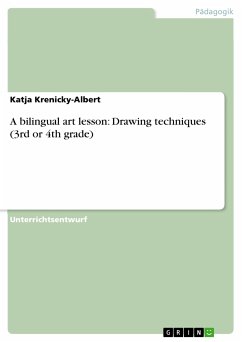Unterrichtsentwurf aus dem Jahr 2004 im Fachbereich Pädagogik - Kunstpädagogik, Note: 1,0, Pädagogische Hochschule Freiburg im Breisgau, Sprache: Deutsch, Abstract: The following work is a theoretical conception of a bilingual art lesson (English/ German) for primary level to introduce a unit based on drawing techniques. Topic: Fantasy Animals & Wild Things Grade:3 or 4, primary school Subject:Art in English Practical task:Inventing and drawing a fantasy animal Technique/ Materials: C 1st alternative:pencil/ black crayon/ felt pen/ wax crayons on white DIN A 3 paper C 2nd alternative:quill & Indian ink on white DIN A 3 paper C 3rd alternative: white crayons/ white wax crayons on black paper C 4th alternative:scratched drawing into a layer of wax (bright wax crayons) and dark watercolours on paper. Time required:a double lesson (2 x 45 minutes) Besides information about the content and its objectives this work outlines methodical considerations regarding process objectives, intelligences engaged and skills needed, special needs as well as links to long term planning. Specific learning goals are reflected and a detailed lesson plan is presented comprising introduction, exploration, practical working phase, closure and assessment. Finally, additional alternatives are given.

